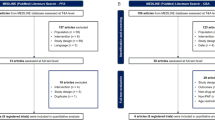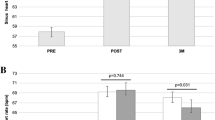Abstract
Background
Limited information is available about focal atrial tachycardia (AT) arising from cavotricuspid isthmus (CTI).
Objective
The purpose of this study is to evaluate the electrocardiographic and electrophysiologic characteristics of a focal AT arising from the CTI.
Methods
From a consecutive series of 92 patients undergoing radiofrequency catheter ablation (RFCA) for focal AT, three (4.4%) patients (three men) with a focal AT arising from the CTI were studied.
Results
The median age was 71 years (range, 50 to 81 years). None of the patients had a history of CTI-dependent atrial flutter. The electrocardiogram (ECG) of a focal AT showed a significant negative F-wave in the inferior leads. Focal AT could be reproducibly initiated and terminated with programmed stimulation. The focus of the tachycardia was localized to the central isthmus in two and the paraseptal isthmus in one patient. The median tachycardia cycle length was 275 ms (range, 260 to 310 ms). In two patients, the focal AT was adenosine insensitive. In all of the patients, tachycardia was entrained from multiple right atrial sites, including the earliest activation site. RFCA was acutely successful in all patients. Long-term success was achieved in all patients over the median follow-up of 18 months (range, 6 to 33 months).
Conclusions
Cavotricuspid isthmus is an uncommon site of origin for focal AT. This focal AT has unique electrocardiographic characteristics such as saw-tooth morphology on ECG and is suggested to be caused by a focal reentrant circuit located at the CTI. Long-term success is achieved with focal ablation.






Similar content being viewed by others
References
Kalman, J. M., Olgin, J. E., Karch, M. R., Hamdan, M., Lee, R. J., & Lesh, M. D. (1998). “Cristal tachycardias”: origin of right atrial tachycardias from the crista terminalis identified by intracardiac echocardiography. Journal of the American College of Cardiology, 31, 451–459.
Morton, J. B., Sanders, P., Das, A., Vohra, J. K., Sparks, P. B., & Kalman, J. M. (2001). Focal atrial tachycardia arising from the tricuspid annulus: electrophysiologic and electrocardiographic characteristics. Journal of Cardiovascular Electrophysiology, 12, 653–659.
Iesaka, Y., Takahashi, A., Goya, M., Soejima, Y., Okamoto, Y., Fujiwara, H., et al. (1997). Adenosine-sensitive atrial reentrant tachycardia originating from the atrioventricular nodal transitional area. Journal of Cardiovascular Electrophysiology, 8, 854–864.
Saoudi, N., Cosio, F., Waldo, A., Chen, S. A., Iesaka, Y., Lesh, M., et al. (2001). A classification of atrial flutter and regular atrial tachycardia according to electrophysiological mechanisms and anatomical bases; a Statement from a Joint Expert Group from The Working Group of Arrhythmias of the European Society of Cardiology and the North American Society of Pacing and Electrophysiology. European Heart Journal, 22, 1162–1182.
Kistler, P. M., Sanders, P., Hussin, A., Morton, J. B., Vohra, J. K., Sparks, P. B., et al. (2003). Focal atrial tachycardia arising from the mitral annulus: electrocardiographic and electrophysiologic characterization. Journal of the American College of Cardiology, 41, 2212–2219.
Kistler, P. M., Sanders, P., Fynn, S. P., Stevenson, I. H., Hussin, A., Vohra, J. K., et al. (2003). Electrophysiological and electrocardiographic characteristics of focal atrial tachycardia originating from the pulmonary veins: acute and long-term outcomes of radiofrequency ablation. Circulation, 108, 1968–1975.
Yamada, T., McElderry, H. T., Allred, J. D., Doppalapudi, H., & Kay, G. N. (2010). Atrial tachycardia originating from the cavo-tricuspid isthmus may exhibit narrow P waves. Indian Pacing and Electrophysiology Journal, 10, 152–155.
Barbato, G., Carinci, V., Tomasi, C., Frassineti, V., Margheri, M., & Di Pasquale, G. (2009). Is electrocardiography a reliable tool for identifying patients with isthmus-dependent atrial flutter? Europace, 11, 1071–1076.
Ito, S., Tada, H., Nogami, A., Naito, S., Oshima, S., & Taniguchi, K. (2007). Atrial tachycardia arising from the right atrial inferoseptum masquerading as common atrial flutter. Circulation Journal, 71, 160–165.
Okumura, K., Plumb, V. J., Page, P. L., & Waldo, A. L. (1991). Atrial activation sequence during atrial flutter in the canine pericarditis model and its effects on the polarity of the flutter wave in the electrocardiogram. Journal of the American College of Cardiology, 17, 509–518.
Marine, J. E., Korley, V. J., Obioha-Ngwu, O., Chen, J., Zimetbaum, P., Papageorgiou, P., et al. (2001). Different patterns of interatrial conduction in clockwise and counterclockwise atrial flutter. Circulation, 104, 1153–1157.
Markowitz, S. M., Nemirovksy, D., Stein, K. M., Mittal, S., Iwai, S., Shah, B. K., et al. (2007). Adenosine-insensitive focal atrial tachycardia: evidence for de novo micro-re-entry in the human atrium. Journal of the American College of Cardiology, 49, 1324–1333.
De Groot, N. M., & Schalij, M. J. (2006). Fragmented, long-duration, low-amplitude electrograms characterize the origin of focal atrial tachycardia. Journal of Cardiovascular Electrophysiology, 17, 1086–1092.
Yang, Y., Varma, N., Keung, E. C., & Scheinman, M. M. (2005). Reentry within the cavotricuspid isthmus: an isthmus dependent circuit. Pacing and Clinical Electrophysiology, 28, 808–818.
Yang, Y., Varma, N., Badhwar, N., Tanel, R. E., Sundara, S., Lee, R. J., et al. (2010). Prospective observations in the clinical and electrophysiological characteristics of intra-isthmus reentry. Journal of Cardiovascular Electrophysiology, 21, 1099–1106.
McGuire, M. A., de Bakker, J. M., Vermeulen, J. T., Moorman, A. F., Loh, P., Thibault, B., et al. (1996). Atrioventricular junctional tissue. Discrepancy between histological and electrophysiological characteristics. Circulation, 94, 571–577.
Author information
Authors and Affiliations
Corresponding author
Rights and permissions
About this article
Cite this article
Sato, H., Yagi, T., Namekawa, A. et al. Focal atrial tachycardia arising from the cavotricuspid isthmus with saw-tooth morphology on the surface ECG: electrocardiographic and electrophysiologic characteristics. J Interv Card Electrophysiol 33, 127–133 (2012). https://doi.org/10.1007/s10840-011-9622-9
Received:
Accepted:
Published:
Issue Date:
DOI: https://doi.org/10.1007/s10840-011-9622-9




